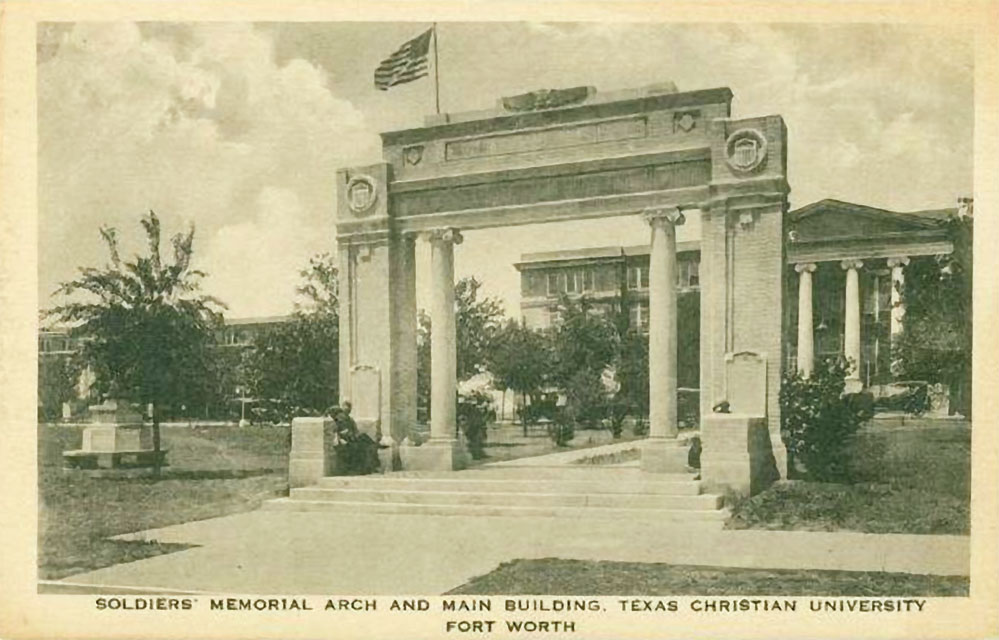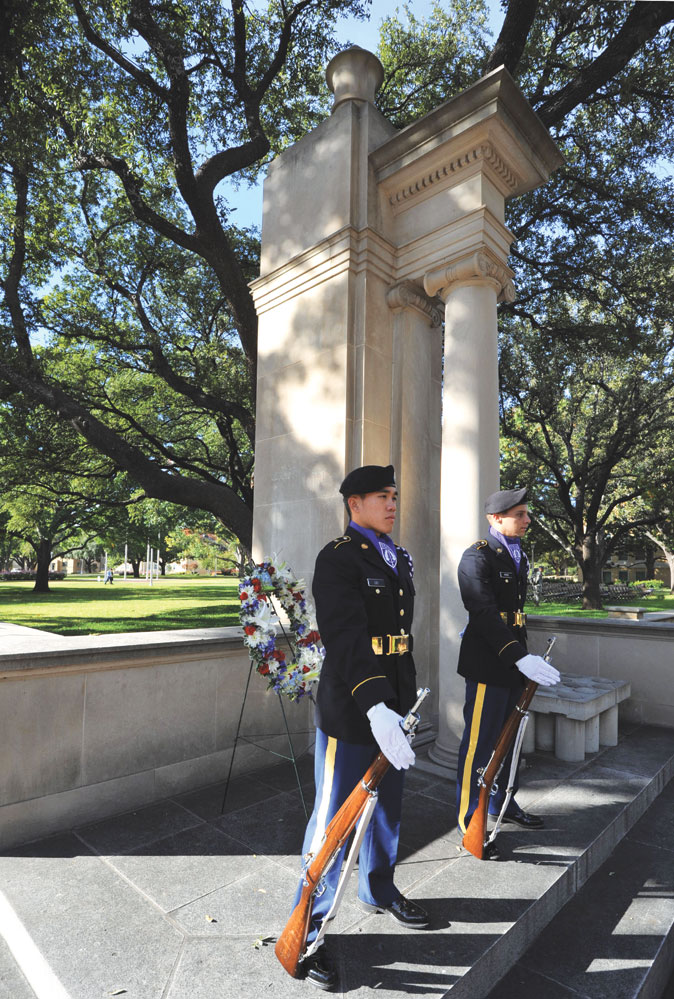TCU’s Memorial Arch dedicated to those who served humanity
TCU’s Memorial Arch traces its roots to 1923 and is dedicated to those who fought in World War I.

The TCU Class of 1923 raised money to build a memorial arch in honor of military men and women who served in World War I. Below, part of the arch still stands in front of Reed Hall. (Photo by Glen E. Ellman)
TCU’s Memorial Arch dedicated to those who served humanity
TCU’s Memorial Arch traces its roots to 1923 and is dedicated to those who fought in World War I.
The streets of Bosnia were a world away from the quiet campus of TCU, but in June 1914, the assassination of Archduke Franz Ferdinand of Austria in the streets of Sarajevo would eventually transform the university, the United States, Europe and the world. A month later, Austria-Hungary declared war against Serbia in what would become World War I.
By 1917, the United States had joined the Allied Powers of Great Britain, France, Italy, Russia and Japan in battle against Germany, Austria-Hungary and the Ottoman Empire. Broadway actor-producer George M. Cohan penned the anthem “Over There” to tell Europe “The Yanks are coming” and Uncle Sam began enlisting a generation of soldiers including those enrolled at college campuses like TCU.
Dean Emeritus Colby D. Hall described the war’s years at TCU as “full of confusion . . . [and] unpreparedness.” Hasty attempts were made to prepare students for military service, and in May 1918, Secretary of War Newton Baker outlined the plans for what came to be called the Students’ Army Training Corps.
In September of that year, President E.M. Waits returned from meetings at the War Department with the details of the program, which provided young men accepted into the program with free college tuition, room and board, uniforms and the pay of a private.
Waits said that the university would “put forth every effort to care for all student soldiers who desire to register. If it becomes necessary, comfortable barracks will be erected on the campus to house the dormitory overflow.”
No expansion of living quarters became necessary though as Armistice came by November of that year and the program was suspended in December.
Support for the war was strong on campus. TCU students contributed nearly $2,000 of the $65,000 raised from Texas colleges for the “student friendship war fund,” a nationwide movement to send “comforts and entertainment” to college men who were in prison camps.
 By November 1917, physical training for female students was added to the military regimen on campus.
By November 1917, physical training for female students was added to the military regimen on campus.
The Horned Frog yearbook of 1919 included a special section dedicated to the war effort on campus and remembering those who served. In “The Call to Arms,” Dr. E.R. Cockrell was quoted as cheering the students on to service: “You are answering the call of the nation to get a vision of Peace and Liberty. … Go, grasp your opportunity. Help win the war!”
In memory of those who served, the Class of 1923 raised funds for a memorial arch, “dedicated to the men and women who served humanity in the World War of 1917-1918,” with special mention of the three who died in combat, Milus Little Jr., Herndon* (Dick) Hardwick and Aubrey Cooper. The 1919 yearbook also cites students Burton Carpenter, Oscar Johnson and Berthold E. Goebel as dying from illnesses during training.
Cooper, who died July 19, 1918, in France, was the first Fort Worth soldier to die “over there.” He had graduated from TCU in 1916 and joined the staff of First National Bank before entering officers’ training camp. He is buried in Greenwood Cemetery, where a statement from Commander in Chief John J. Pershing is engraved on the back of his tombstone, noting that, “in recognition of his gallant conduct . . . awarded him in the name of the President the Distinguished Service Cross.”
The original Memorial Arch included limestone Ionic columns supporting a flat bricked arch embellished with an entablature containing relief panels of an eagle and cartouches.
The names of the dead from World Wars I and II are inscribed on bronze plaques along with the names of the 1923 senior class.
In 1949, when University Drive was widened, the arch was relocated and modified into two columns, which still stand. As another war had come and gone by this time, the arch was re-dedicated to the dead from all wars.
In a future issue, The TCU Magazine will look back at campus during the World War II years. If you have memories of campus during those war years, please e-mail them to tcumagazine@tcu.edu.

Your comments are welcome
Comments
Related Reading:
Mem’ries Sweet
The Legend of Pico de Gallo
Rockers from the philosophy department remember their band’s heyday, from adoring fans to tanking gigs.
Mem’ries Sweet
Where We Hung Out: TCU’s Lost ’90s Landmarks
TCU’s campus has seen seismic change over the past quarter century, but the memories remain.